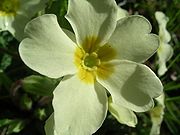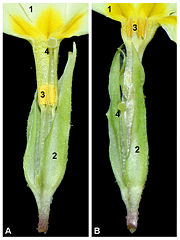
Heterostyly
Encyclopedia



Polymorphism (biology)
Polymorphism in biology occurs when two or more clearly different phenotypes exist in the same population of a species — in other words, the occurrence of more than one form or morph...
and herkogamy
Herkogamy
Herkogamy is a common strategy employed by hermaphroditic angiosperms to reduce sexual interference between male and female function. Herkogamy differs from other such strategies by supplying a spatial separation of the anthers and stigma.Two forms of herkogamy are most common:1...
in flower
Flower
A flower, sometimes known as a bloom or blossom, is the reproductive structure found in flowering plants . The biological function of a flower is to effect reproduction, usually by providing a mechanism for the union of sperm with eggs...
s. In a heterostylous species, two or three different morphological types of flowers, termed morphs, exist in the population. On each individual plant, all flowers share the same morph. The flower morphs differ in the lengths of the pistil and stamen
Stamen
The stamen is the pollen producing reproductive organ of a flower...
s, and these traits are not continuous. The morph phenotype
Phenotype
A phenotype is an organism's observable characteristics or traits: such as its morphology, development, biochemical or physiological properties, behavior, and products of behavior...
is genetically linked
Genetic linkage
Genetic linkage is the tendency of certain loci or alleles to be inherited together. Genetic loci that are physically close to one another on the same chromosome tend to stay together during meiosis, and are thus genetically linked.-Background:...
to gene
Gene
A gene is a molecular unit of heredity of a living organism. It is a name given to some stretches of DNA and RNA that code for a type of protein or for an RNA chain that has a function in the organism. Living beings depend on genes, as they specify all proteins and functional RNA chains...
s responsible for a unique system of self-incompatibility
Self-incompatibility in plants
Self-incompatibility is a general name for several genetic mechanisms in angiosperms, which prevent self-fertilization and thus encourage outcrossing...
, termed heteromorphic self-incompatibility, that is, the pollen from a flower on one morph cannot fertilize another flower of the same morph.
Heterostylous plants having two flower morphs are termed distylous. In one morph (termed pin or longuistylous flower) the stamens are short and the pistils are long; in the second morph (termed thrum or brevistylous flower) the stamens are long and the pistils are short; the length of the pistil in one morph equals the length of the stamens in the second morph, and vice versa. Examples of distylous plants are the primrose
Primula vulgaris
Primula vulgaris is a species of Primula native to western and southern Europe , northwest Africa , and southwest Asia...
and many other Primula
Primula
Primula is a genus of 400–500 species of low-growing herbs in the family Primulaceae. They include primrose, auricula, cowslip and oxlip. Many species are grown for their ornamental flowers...
species, flax
Flax
Flax is a member of the genus Linum in the family Linaceae. It is native to the region extending from the eastern Mediterranean to India and was probably first domesticated in the Fertile Crescent...
and other Linum
Linum
Linum is a genus of approximately 200 species in the flowering plant family Linaceae, native to temperate and subtropical regions of the world. It includes the Common Flax Linum (flax) is a genus of approximately 200 species in the flowering plant family Linaceae, native to temperate and...
species, purple loosestrife
Purple loosestrife
Lythrum salicaria is a flowering plant belonging to the family Lythraceae, native to Europe, Asia, northwest Africa, and southeastern Australia. It should not be confused with other plants sharing the name loosestrife that are members of the family Primulaceae...
and other Lythrum
Lythrum
Lythrum is a genus commonly known as loosestrife. It is one of 32 genera of the family Lythraceae.-Selected species:-Formerly placed here:*Cuphea carthagenensis J.F.Macbr....
species, and many species of Cryptantha
Cryptantha
Cryptantha is a genus of hairy plants in the borage family . Some of them are heterostylous.- Selected species :*Cryptantha abata: Abata Cryptantha, Dent-nut Catseye, Dentnut Cryptantha...
.
Heterostylous plants having three flower morphs are termed tristylous. Each morph has two types of stamens. In one morph, the pistil is short, and the stamens are long and intermediate; in the second morph, the pistil is intermediate, and the stamens are short and long; in the third morph, the pistil is long, and the stamens are short and intermediate. Oxalis pes-caprae
Oxalis pes-caprae
Oxalis pes-caprae is a species of tristylous flowering plant in the wood sorrel family Oxalidaceae...
and some species of Lythrum
Lythrum
Lythrum is a genus commonly known as loosestrife. It is one of 32 genera of the family Lythraceae.-Selected species:-Formerly placed here:*Cuphea carthagenensis J.F.Macbr....
are trimorphic.
The different lengths of stamens and pistils in heterostylous flowers are adapted for pollination
Pollination
Pollination is the process by which pollen is transferred in plants, thereby enabling fertilisation and sexual reproduction. Pollen grains transport the male gametes to where the female gamete are contained within the carpel; in gymnosperms the pollen is directly applied to the ovule itself...
by different pollinator
Pollinator
A pollinator is the biotic agent that moves pollen from the male anthers of a flower to the female stigma of a flower to accomplish fertilization or syngamy of the female gamete in the ovule of the flower by the male gamete from the pollen grain...
s, or different body parts of the same pollinator. Thus, pollen
Pollen
Pollen is a fine to coarse powder containing the microgametophytes of seed plants, which produce the male gametes . Pollen grains have a hard coat that protects the sperm cells during the process of their movement from the stamens to the pistil of flowering plants or from the male cone to the...
originating in a long stamen will reach primarily long rather than short pistils, and vice versa. When pollen is transferred between two flowers of the same morph, no fertilization will take place, because of the self-incompatibility mechanism.

